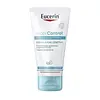What's inside
What's inside
 Key Ingredients
Key Ingredients

 Benefits
Benefits

 Concerns
Concerns

 Ingredients Side-by-side
Ingredients Side-by-side

Water
Skin ConditioningCaprylic/Capric Triglyceride
MaskingGlycerin
HumectantPentylene Glycol
Skin ConditioningOlea Europaea Fruit Oil
MaskingPanthenol
Skin ConditioningCetearyl Alcohol
EmollientButyrospermum Parkii Butter
Skin ConditioningGlyceryl Stearate Citrate
EmollientLimnanthes Alba Seed Oil
Skin ConditioningButylene Glycol
HumectantHydrogenated Lecithin
EmulsifyingCeramide NP
Skin ConditioningSodium PCA
HumectantSqualane
EmollientStearyl Glycyrrhetinate
Skin ConditioningCarbomer
Emulsion StabilisingSodium Carbomer
Emulsion StabilisingXanthan Gum
EmulsifyingHydroxyphenyl Propamidobenzoic Acid
Skin ConditioningWater, Caprylic/Capric Triglyceride, Glycerin, Pentylene Glycol, Olea Europaea Fruit Oil, Panthenol, Cetearyl Alcohol, Butyrospermum Parkii Butter, Glyceryl Stearate Citrate, Limnanthes Alba Seed Oil, Butylene Glycol, Hydrogenated Lecithin, Ceramide NP, Sodium PCA, Squalane, Stearyl Glycyrrhetinate, Carbomer, Sodium Carbomer, Xanthan Gum, Hydroxyphenyl Propamidobenzoic Acid
Water
Skin ConditioningGlycerin
HumectantOctyldodecanol
EmollientCetyl Alcohol
EmollientGlyceryl Stearate
EmollientCaprylic/Capric Triglyceride
MaskingMethylpropanediol
SolventStearyl Alcohol
EmollientHydrogenated Coco-Glycerides
EmollientButyrospermum Parkii Butter
Skin ConditioningGlyceryl Stearate Se
EmulsifyingCetyl Palmitate
EmollientColloidal Oatmeal
AbsorbentGlycyrrhiza Inflata Root Extract
Skin ConditioningCeramide NP
Skin ConditioningPhytosphingosine
Skin ConditioningMenthoxypropanediol
MaskingGlycine
BufferingSodium PCA
HumectantDecylene Glycol
Skin ConditioningCitric Acid
BufferingSodium Citrate
BufferingSodium Cetearyl Sulfate
CleansingCaprylyl Glycol
EmollientOleic Acid
EmollientEthylhexylglycerin
Skin ConditioningPhenoxyethanol
PreservativeBenzyl Alcohol
PerfumingWater, Glycerin, Octyldodecanol, Cetyl Alcohol, Glyceryl Stearate, Caprylic/Capric Triglyceride, Methylpropanediol, Stearyl Alcohol, Hydrogenated Coco-Glycerides, Butyrospermum Parkii Butter, Glyceryl Stearate Se, Cetyl Palmitate, Colloidal Oatmeal, Glycyrrhiza Inflata Root Extract, Ceramide NP, Phytosphingosine, Menthoxypropanediol, Glycine, Sodium PCA, Decylene Glycol, Citric Acid, Sodium Citrate, Sodium Cetearyl Sulfate, Caprylyl Glycol, Oleic Acid, Ethylhexylglycerin, Phenoxyethanol, Benzyl Alcohol
 Reviews
Reviews

Ingredients Explained
These ingredients are found in both products.
Ingredients higher up in an ingredient list are typically present in a larger amount.
This ingredient is also known as shea butter. It is an effective skin hydrator and emollient.
Emollients help soothe and soften your skin. It does this by creating a protective film on your skin. This barrier helps trap moisture and keeps your skin hydrated. Emollients may be effective at treating dry or itchy skin.
Shea butter is rich in antioxidants. Antioxidants help fight free-radicals, or molecules that may harm the body. It is also full of fatty acids including stearic acid and linoleic acid. These acids help replenish the skin and keep skin moisturized.
While Shea Butter has an SPF rating of about 3-4, it is not a sunscreen replacement.
Shea butter may not be fungal acne safe. We recommend speaking with a professional if you have any concerns.
Learn more about Butyrospermum Parkii ButterThis ingredient is an emollient, solvent, and texture enhancer. It is considered a skin-softener by helping the skin prevent moisture loss.
It helps thicken a product's formula and makes it easier to spread by dissolving clumping compounds.
Caprylic Triglyceride is made by combining glycerin with coconut oil, forming a clear liquid.
While there is an assumption Caprylic Triglyceride can clog pores due to it being derived from coconut oil, there is no research supporting this.
Learn more about Caprylic/Capric TriglycerideCeramide NP is a type of ceramide and formally known as ceramide 3.
Ceramides are intercellular lipids naturally found in our skin that bonds dead skin cells together to create a barrier. They are known for their ability to hold water and thus are a great ingredient for dry skin.
Ceramides are an important building block for our skin barrier. A stronger barrier helps the skin look more firm and hydrated. By bolstering the skin ceramides act as a barrier against irritating ingredients. This can help with inflammation as well.
If you would like to eat ceramides, sweet potatoes contain a small amount.
Read more about other common types of ceramides here:
Ceramide AP
Ceramide EOP
Glycerin is already naturally found in your skin. It helps moisturize and protect your skin.
A study from 2016 found glycerin to be more effective as a humectant than AHAs and hyaluronic acid.
As a humectant, it helps the skin stay hydrated by pulling moisture to your skin. The low molecular weight of glycerin allows it to pull moisture into the deeper layers of your skin.
Hydrated skin improves your skin barrier; Your skin barrier helps protect against irritants and bacteria.
Glycerin has also been found to have antimicrobial and antiviral properties. Due to these properties, glycerin is often used in wound and burn treatments.
In cosmetics, glycerin is usually derived from plants such as soybean or palm. However, it can also be sourced from animals, such as tallow or animal fat.
This ingredient is organic, colorless, odorless, and non-toxic.
Glycerin is the name for this ingredient in American English. British English uses Glycerol/Glycerine.
Learn more about GlycerinSodium PCA is the sodium salt of pyroglutamic acid. It is naturally occurring in our skin's natural moisturizing factors where it works to maintain hydration.
The PCA stands for pyrrolidone carboxylic acid, a natural amino acid derivative.
This ingredient has skin conditioning, anti-inflammatory, and humectant properties. Humectants help hydrate your skin by drawing moisture from the air. This helps keep your skin moisturized.
Learn more about Sodium PCAWater. It's the most common cosmetic ingredient of all. You'll usually see it at the top of ingredient lists, meaning that it makes up the largest part of the product.
So why is it so popular? Water most often acts as a solvent - this means that it helps dissolve other ingredients into the formulation.
You'll also recognize water as that liquid we all need to stay alive. If you see this, drink a glass of water. Stay hydrated!
Learn more about Water